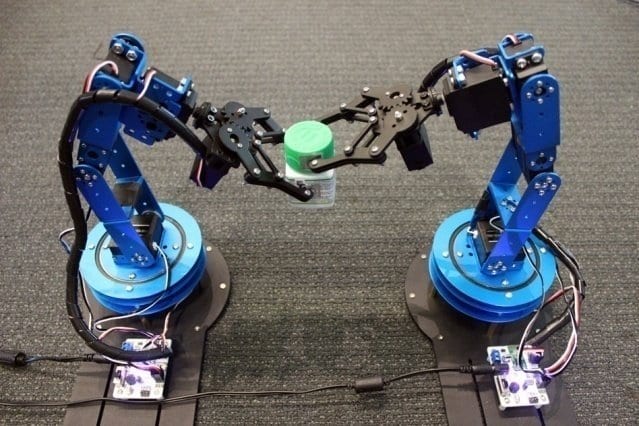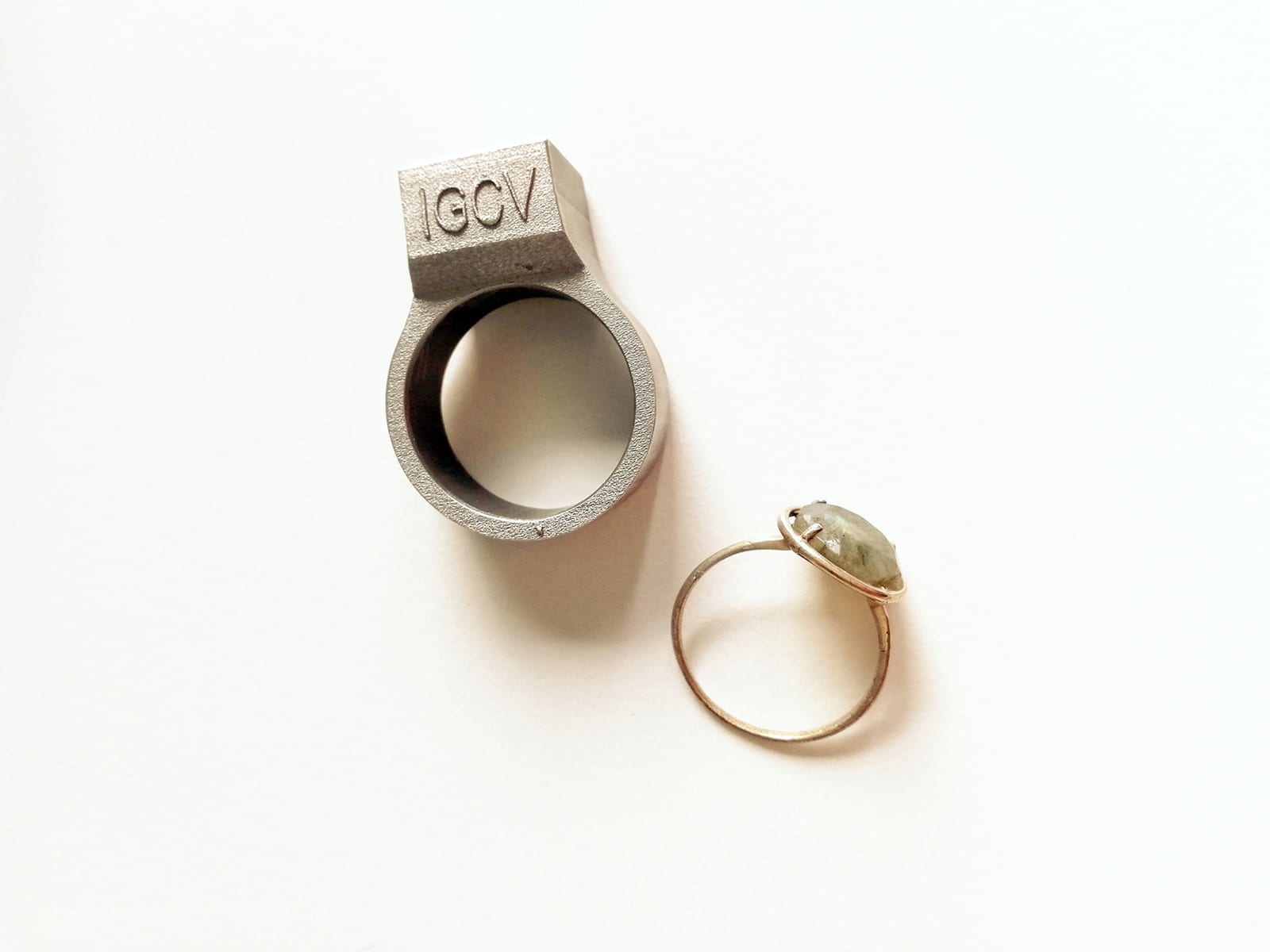
Photo courtesy of the researchers
System uses RFID tags to home in on targets; could benefit robotic manufacturing, collaborative drones, and other applications.
A novel system developed at MIT uses RFID tags to help robots home in on moving objects with unprecedented speed and accuracy. The system could enable greater collaboration and precision by robots working on packaging and assembly, and by swarms of drones carrying out search-and-rescue missions.
In a paper being presented next week at the USENIX Symposium on Networked Systems Design and Implementation, the researchers show that robots using the system can locate tagged objects within 7.5 milliseconds, on average, and with an error of less than a centimeter.
In the system, called TurboTrack, an RFID (radio-frequency identification) tag can be applied to any object. A reader sends a wireless signal that reflects off the RFID tag and other nearby objects, and rebounds to the reader. An algorithm sifts through all the reflected signals to find the RFID tag’s response. Final computations then leverage the RFID tag’s movement — even though this usually decreases precision — to improve its localization accuracy.
The researchers say the system could replace computer vision for some robotic tasks. As with its human counterpart, computer vision is limited by what it can see, and it can fail to notice objects in cluttered environments. Radio frequency signals have no such restrictions: They can identify targets without visualization, within clutter and through walls.
To validate the system, the researchers attached one RFID tag to a cap and another to a bottle. A robotic arm located the cap and placed it onto the bottle, held by another robotic arm. In another demonstration, the researchers tracked RFID-equipped nanodrones during docking, maneuvering, and flying. In both tasks, the system was as accurate and fast as traditional computer-vision systems, while working in scenarios where computer vision fails, the researchers report.
“If you use RF signals for tasks typically done using computer vision, not only do you enable robots to do human things, but you can also enable them to do superhuman things,” says Fadel Adib, an assistant professor and principal investigator in the MIT Media Lab, and founding director of the Signal Kinetics Research Group. “And you can do it in a scalable way, because these RFID tags are only 3 cents each.”
In manufacturing, the system could enable robot arms to be more precise and versatile in, say, picking up, assembling, and packaging items along an assembly line. Another promising application is using handheld “nanodrones” for search and rescue missions. Nanodrones currently use computer vision and methods to stitch together captured images for localization purposes. These drones often get confused in chaotic areas, lose each other behind walls, and can’t uniquely identify each other. This all limits their ability to, say, spread out over an area and collaborate to search for a missing person. Using the researchers’ system, nanodrones in swarms could better locate each other, for greater control and collaboration.
“You could enable a swarm of nanodrones to form in certain ways, fly into cluttered environments, and even environments hidden from sight, with great precision,” says first author Zhihong Luo, a graduate student in the Signal Kinetics Research Group.
Learn more: Robots track moving objects with unprecedented precision
The Latest on: Nanodrones
[google_news title=”” keyword=”nanodrones” num_posts=”10″ blurb_length=”0″ show_thumb=”left”]
via Google News
The Latest on: Nanodrones
- From generators and sonars to tanks and drones: What assistance Ukraine received from UKon April 26, 2024 at 12:43 pm
Great Britain is providing significant support to Ukraine, delivering military, humanitarian, and energy assistance to Kyiv. This includes tanks, missiles, generators, civilian vehicles, and much more ...
- Emergency Procurement Powers Help Army To Modernise Itself: M Pandeon April 24, 2024 at 6:38 pm
Army Chief General Manoj Pande on Wednesday said that emergency procurement powers given by the government has helped the force to modernise itself. General Manoj Pande was addressing the Seminar ...
- Technology new strategic arena of competition, driving geo-political powerplay: Army Chiefon April 24, 2024 at 7:05 am
The Army Chief said emergency procurement powers given by the Centre has helped the force to modernise itself.
- Emergency Procurement Powers Help Army To Modernise Itself: Army Chiefon April 24, 2024 at 2:40 am
Army Chief General Manoj Pande on Wednesday said that emergency procurement powers given by the government has helped the force to modernise itself. General Manoj Pande was addressing the Seminar ...
- Emergency procurement powers help Army to modernise itself: Gen Manoj Pandeon April 24, 2024 at 2:12 am
The Army Chief said that towards improving mobility and protection, procurements include Light Strike Vehicle, Light Specialist Vehicles and Bullet Proof Jackets ...
- Military strength, capabilities essential to prevent wars, says Army chiefon April 23, 2024 at 6:16 pm
The current geo-strategic landscape is characterised by a change that is taking place at an "unprecedented" scale and speed, Army Chief Gen Manoj Pande said on Tuesday while asserting that military ...
- Military Strength and Capabilities Essential for Peace, Says Army Chiefon April 23, 2024 at 11:24 am
Gen Manoj Pande highlights the importance of military capabilities in maintaining peace and ensuring national security amid global geopolitical shifts.
- Military strength, capabilities necessary to prevent wars, says Army chiefon April 23, 2024 at 7:27 am
Army Chief Gen Manoj Pande emphasized the importance of military strength and capabilities in preventing wars and protecting national interests in the face of recent geopolitical changes. He ...
- Ultimate Spider-Man #4 Preview: JJJ Stirs the Poton April 21, 2024 at 12:26 pm
Final phase will mimic Spider-Man's network of allies, by deploying nano-drones disguised as common technology to surveil and control populations unnoticeably. Through this intricate technology web, ...
- Orion Technology Group Integrates Doodle Labs Datalinks Into X BLUE NANO Line Of Ultra Small Nano-Droneson April 19, 2024 at 10:18 am
Orion Technology Group, a manufacturer of advanced artificial intelligence UxVs and mission software, today announced the integrati ...
via Bing News










